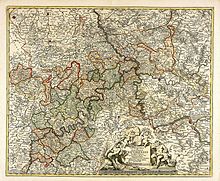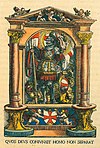Electorate of Trier
This article needs additional citations for verification. (December 2015) |
Electorate of Trier | |||||||||||||
|---|---|---|---|---|---|---|---|---|---|---|---|---|---|
| 898–1801 | |||||||||||||
Prince Clemens Wenceslaus of Saxony | |||||||||||||
| Historical era | |||||||||||||
• Autonomy granted | 772 | ||||||||||||
| 898 | |||||||||||||
• Raised to electorate | between 1189 and 1212 | ||||||||||||
| 1212 | |||||||||||||
• Joined Electoral Rhenish Circle | 1512 | ||||||||||||
| 9 February 1801 | |||||||||||||
| 9 June 1815 | |||||||||||||
| |||||||||||||




The Electorate of Trier (
The capital of the electorate was Trier; from the 16th century onward, the main residence of the Elector was in Koblenz. The electorate was secularized in 1803 in the course of the German mediatisation.
The Elector of Trier, in his capacity as archbishop, also administered the Archdiocese of Trier, whose territory did not correspond to the electorate (see map below).
History
Middle ages
The bishops of Trier were already virtually independent territorial magnates during the
At the partition of the
In 898, Archbishop
Early modern
In early modern times, the Electorate of Trier still encompassed territory along the river
In 1473, Emperor
In the 17th century, the Archbishops and Prince-Electors of Trier relocated their residences to Philippsburg Castle in Ehrenbreitstein, near Koblenz.
During the Thirty Years' War, Archbishop-Elector Philipp Christoph von Sötern supported France against the Habsburgs, leading to a rivalry between French and Spanish troops about the strategic cities and fortresses of the Electorate. In 1630, the city of Trier opened its gates to Spanish troops to defend its rights against the absolutist Elector. French troops captured the city in 1632 to help Sötern. In return, they were allowed to install garrisons there and in the fortress of Ehrenbreitstein. Spanish troops retook Trier by surprise in 1635 and imprisoned Sötern. During his absence, the cathedral chapter took over administration of the archbishopric. Imperial troops dispelled the French garrison of Ehrenbreitstein in 1637 and occupied the place until the end of the war. The archbishop was released from captivity in 1645 because of French demands in Westphalia.[1]
Warfare returned to the Electorate in 1673 during the Franco-Dutch War, when the French Army occupied Trier and stayed until 1675. They heavily fortified the city and destroyed all churches, abbeys and settlements in front of the city walls.
In 1684, with the
During the
The last elector, Clemens Wenceslaus, resided exclusively in Koblenz after 1786. From 1795, the territories of the Electorate on the left bank of the Rhine were under French occupation; in 1801, they were annexed and a separate French-controlled diocese established under Bishop Charles Mannay. In 1803, the French diocese assumed control of the whole diocese and what was left of the electoral territory on the eastern bank of the Rhine was secularized and annexed by Nassau-Weilburg in 1803.
Archbishop-Electors of Trier
- John I1189–1212
- Theoderich von Wied 1212–1242
- Arnold II von Isenburg 1242–1259
- Heinrich II von Finstingen 1260–1286
- Bohemond I von Warnesberg1286–1299
- Diether von Nassau 1300–1307
- Heinrich II von Virneburg1300–1306 (in opposition)
- Baldwin von Luxemburg1307–1354
- Bohemond II von Saarbrücken1354–1362
- Kuno II von Falkenstein 1362–1388
- Werner von Falkenstein 1388–1418
- Otto von Ziegenhain 1418–1430
- Raban von Helmstatt 1430–1438
- Jakob I von Sierck 1439–1456
- John II of Baden 1456–1503
- Jakob II von Baden 1503–1511
- Richard von Greiffenklau zu Vollrads 1511–1531
- Johann von Metzenhausen 1531–40
- Johann Ludwig von Hagen 1540–47
- John of Isenburg-Grenzau 1547–56
- Johann von der Leyen 1556–67
- Jakob von Eltz-Rübenach 1567–81
- Johann von Schönenberg 1581–99
- Lothar von Metternich 1599–1623
- Philipp Christoph von Sötern 1623–52
- Karl Kaspar von der Leyen-Hohengeroldseck1652–76
- Johann Hugo von Orsbeck 1676–1711
- Charles Joseph of Lorraine 1711–15
- Franz Ludwig of Palatinate-Neuburg1716–29
- Franz Georg von Schönborn-Buchheim1729–56
- Johann IX Philipp von Walderdorff 1756–68
- Prince Clemens Wenceslaus of Saxony 1768–1803[2]
Footnotes
- ^ Wagner, Paul (1888), "Philipp Christoph v. Sötern", Allgemeine Deutsche Biographie (in German), vol. 26, Leipzig: Duncker & Humblot, pp. 50–69
- ^ From 1794, after the French conquest of the Imperial territories on the left-bank of the Rhine, Clemens Wenceslaus of Saxony was archbishop with effect on the right bank only.





